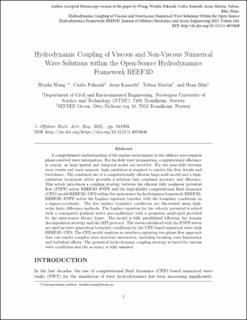| dc.contributor.author | Wang, Weizhi | |
| dc.contributor.author | Pakozdi, Csaba | |
| dc.contributor.author | Kamath, Arun | |
| dc.contributor.author | Martin, Tobias | |
| dc.contributor.author | Bihs, Hans | |
| dc.date.accessioned | 2023-06-27T12:59:27Z | |
| dc.date.available | 2023-06-27T12:59:27Z | |
| dc.date.created | 2023-01-06T14:26:03Z | |
| dc.date.issued | 2022 | |
| dc.identifier.citation | Journal of Offshore Mechanics and Arctic Engineering. 2022, 144 (4), . | en_US |
| dc.identifier.issn | 0892-7219 | |
| dc.identifier.uri | https://hdl.handle.net/11250/3073525 | |
| dc.description.abstract | A comprehensive understanding of the marine environment in the offshore area requires phase-resolved wave information. For far-field wave propagation, computational efficiency is crucial, as large spatial and temporal scales are involved. For the near-field extreme wave events and wave impacts, high resolution is required to resolve the flow details and turbulence. The combined use of a computationally efficient large-scale model and a high-resolution local-scale solver provides a solution that combines accuracy and efficiency. This article introduces a coupling strategy between the efficient fully nonlinear potential flow (FNPF) solver REEF3D::FNPF and the high-fidelity computational fluid dynamics (CFD) model REEF3D::CFD within the open-source hydrodynamics framework REEF3D. REEF3D::FNPF solves the Laplace equation together with the boundary conditions on a sigma-coordinate. The free surface boundary conditions are discretized using high-order finite difference methods. The Laplace equation for the velocity potential is solved with a conjugated gradient solver preconditioned with a geometric multigrid provided by the open-source library Hypre. The model is fully parallelized following the domain decomposition strategy and the message passing interface protocol. The waves calculated with the FNPF solver are used as wave generation boundary conditions for the CFD-based numerical wave tank REEF3D::CFD. The CFD model employs an interface capturing two-phase flow approach that can resolve complex wave structure interaction, including breaking wave kinematics and turbulent effects. The presented hydrodynamic coupling strategy is tested for various wave conditions and the accuracy is fully assessed. | en_US |
| dc.language.iso | eng | en_US |
| dc.publisher | ASME | en_US |
| dc.subject | Hydrodynamic coupling | en_US |
| dc.subject | Potential flow solver | en_US |
| dc.subject | CFD | en_US |
| dc.subject | REEF3D | en_US |
| dc.title | Hydrodynamic Coupling of Viscous and Nonviscous Numerical Wave Solutions Within the Open-Source Hydrodynamics Framework REEF3D | en_US |
| dc.title.alternative | Hydrodynamic Coupling of Viscous and Nonviscous Numerical Wave Solutions Within the Open-Source Hydrodynamics Framework REEF3D | en_US |
| dc.type | Journal article | en_US |
| dc.type | Peer reviewed | en_US |
| dc.description.version | acceptedVersion | en_US |
| dc.rights.holder | ASME | en_US |
| dc.source.pagenumber | 8 | en_US |
| dc.source.volume | 144 | en_US |
| dc.source.journal | Journal of Offshore Mechanics and Arctic Engineering | en_US |
| dc.source.issue | 4 | en_US |
| dc.identifier.doi | 10.1115/1.4053848 | |
| dc.identifier.cristin | 2102212 | |
| cristin.ispublished | true | |
| cristin.fulltext | postprint | |
| cristin.qualitycode | 2 | |
